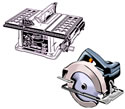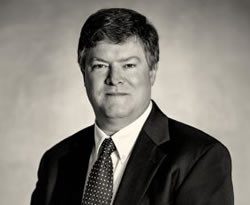 Approximately 125,000 serious injuries occur in the US each year related to the use of portable and fixed power saws. Lacerations and similar injuries, such as abrasions and avulsions, account for over 90% of these, which generally occur to males and result in losses in the tens of millions of dollars annually. Although hand and finger blade contact is involved in most of these accidents, a significant number involve kickback of the work-piece for fixed saws or kickback of the tool for hand held units. In many of these cases, a blade-guard or anti-kickback device was either not in place or failed to operate properly.
Approximately 125,000 serious injuries occur in the US each year related to the use of portable and fixed power saws. Lacerations and similar injuries, such as abrasions and avulsions, account for over 90% of these, which generally occur to males and result in losses in the tens of millions of dollars annually. Although hand and finger blade contact is involved in most of these accidents, a significant number involve kickback of the work-piece for fixed saws or kickback of the tool for hand held units. In many of these cases, a blade-guard or anti-kickback device was either not in place or failed to operate properly.
Expertise
We are familiar with the various standards associated with power saws and have been involved in scores of investigations associated with all types of saws including:
- Table, bench and arbor saws
- Circular hand saws
- Chainsaws
- Radial arm saws
- Miter saws
Questions Answered
Through scientific analysis, we can help you answer pertinent questions such as:
- Was the saw being used properly?
- Did the blade-guard function as intended?
- Would a proper interlock device have avoided use without a blade guard?
- Were the warning and instructions provided with the unit adequate?
Case Examples
Hand-held Circular Saw Kickback:
A man was using a hand-held circular saw to cut a piece of wood when the blade encountered a knot. The saw kicked back but the blade-guard did not cover the blade in time, allowing the rotating blade to cut the man's free hand. The defense argued that the sticking blade guard became bent when the user dropped the saw. Through testing, we showed that the blade-guard had been manufactured with a bend, resulting in its sticking open before it covered the blade.
Table Saw Blade Contacts Operator's Hand:
The promising career of a jazz musician ended abruptly after a table saw he was using injured his right hand. Dr. Ojalvo demonstrated to the court that it was technically and economically feasible to install a safety interlock mechanism, which would shut off power to the blade when the guard was removed. As a result, the jury awarded the Plaintiff $1.6 million in damages.
Kristopher J. Seluga, PE, is a Mechanical Engineering, Accident Reconstruction, Biomechanics, and Safety Expert with over 20 years of experience. He received his Bachelor's and Master's degrees from the Mechanical Engineering department at MIT where he worked on the development of novel three-dimensional printing technologies. Mr. Seluga is also a licensed Professional Engineer in New York and Connecticut, and has served as a member of the ANSI engineering committee for the Z130.1 and Z135 standards for golf cars and PTV's. His research interests and peer reviewed publications span the topics of Motor Vehicle Dynamics, Product Safety, and Biomechanics.
©Copyright - All Rights Reserved
DO NOT REPRODUCE WITHOUT WRITTEN PERMISSION BY AUTHOR.



 Approximately 125,000 serious injuries occur in the US each year related to the use of portable and fixed power saws. Lacerations and similar injuries, such as abrasions and avulsions, account for over 90% of these, which generally occur to males and result in losses in the tens of millions of dollars annually. Although hand and finger blade contact is involved in most of these accidents, a significant number involve kickback of the work-piece for fixed saws or kickback of the tool for hand held units. In many of these cases, a blade-guard or anti-kickback device was either not in place or failed to operate properly.
Approximately 125,000 serious injuries occur in the US each year related to the use of portable and fixed power saws. Lacerations and similar injuries, such as abrasions and avulsions, account for over 90% of these, which generally occur to males and result in losses in the tens of millions of dollars annually. Although hand and finger blade contact is involved in most of these accidents, a significant number involve kickback of the work-piece for fixed saws or kickback of the tool for hand held units. In many of these cases, a blade-guard or anti-kickback device was either not in place or failed to operate properly.








